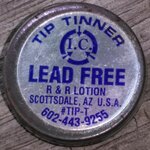userx2
Full Member level 3
I have a Weller TCP-01.
I do not use it often.
The tips have recently started not taking on solder and have a dark blueish dull look.
I tried cleaning them with all sorts of stuff from sponge to steel-wool to brass wire brush and eventually sanding paper.
I also tried citric acid as well as flux.
All to no avail.
Is there a way to clean these tips to make them work again?
I have replaced one tip with a new one but now notice this is possibly starting to happen. The tip is turning dark again after a relatively short period.
The solder is the same roll I have been using for many years.
I am not sure if relevant, but I replaced the element of that soldering iron not that long ago.
Does anyone else know more?
Best regards
X
I do not use it often.
The tips have recently started not taking on solder and have a dark blueish dull look.
I tried cleaning them with all sorts of stuff from sponge to steel-wool to brass wire brush and eventually sanding paper.
I also tried citric acid as well as flux.
All to no avail.
Is there a way to clean these tips to make them work again?
I have replaced one tip with a new one but now notice this is possibly starting to happen. The tip is turning dark again after a relatively short period.
The solder is the same roll I have been using for many years.
I am not sure if relevant, but I replaced the element of that soldering iron not that long ago.
Does anyone else know more?
Best regards
X
